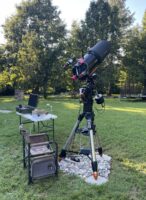Ten thousand years ago, before the dawn of recorded human history, a new light would have suddenly appeared in the night sky and faded after a few weeks. Today we know this light was from a supernova or exploding star, and record the expanding debris cloud as the Veil Nebula, a supernova remnant. This sharp telescopic view is centered on a western segment of the Veil Nebula cataloged as NGC 6960 but less formally known as the Witch’s Broom Nebula or Sharpless 103. Blasted out in the cataclysmic explosion, the interstellar shock wave plows through space sweeping up and exciting interstellar material. Its amazing filamentary structure is thought to be due to the compression of expanding shells of gas as they meet the resistance of the interstellar medium. However, the shells are so thin that, with few exceptions, we see them only where viewed exactly edge-on. Imaged with narrow band filters, the glowing filaments are like long ripples in a sheet seen almost edge-on, remarkably well separated into atomic hydrogen (red) and oxygen (blue-green) gas. The fact that much of what we see as “empty” space is filled with dark dust is evidenced by the fact that more background stars are visible below the nebula than above it. This is because the shock wave has swept the area below the nebula clear of the dust, allowing more background stars to shine through. The complete supernova remnant lies about 1400 light-years away towards the constellation Cygnus. This Witch’s Broom actually spans about 35 light-years. The bright star in the frame is 52 Cygni, visible with the unaided eye from a dark location but unrelated to the ancient supernova remnant.

Witches Broom – Western Veil
- brownmtn
- February 19, 2016
- Uncategorized

